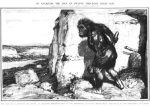
The whole question of how Neanderthals are related to us (modern humans) has been controversial ever since the first Neanderthal bones were found in Germany in the 19th century. Belonging to an elderly, arthritic individual (a good example of how well Neanderthals cared for each other in social groups), the bones were reconstructed to show a stooping individual, with a more ape-like gait, leading to Neanderthals being described as the “Missing Link” between apes and humans, and given the epithet “ape-man”.
Who were the Neanderthals?

Neanderthals lived in the lands surrounding the Mediterranean Sea, and as far east as the Altai Mountains in Central Asia, between about 250,000 and about 30,000 years ago. They were a form of ancient human with certain physical characteristics – many of which probably helped them cope with the cold of Ice Ages. Neanderthals evolved out of an earlier ancestor – Homo erectus, possibly through another species – Homo heidelbergensis. They had a larger brain than modern humans, but it was shaped slightly differently, with less development in the prefrontal cortex, which allows critical thinking and problem-solving, and larger development at the back of the skull, and in areas associated with memory in our brains. It is possible that Neanderthals had excellent memory, but poor analytical skills. They were probably not good at innovation – a skill which became vital as the Ice Age ended and the global climate warmed, sea levels rose and plant and animal habitats changed.
Neanderthals were stockier than modern humans, with shorter arms and legs, and probably stronger and all-round tougher. They had a larger rib cage, and probably bigger lungs, a bigger nose, larger eyes and little to no chin. Most of these adaptations would have helped them in Ice Age Europe and Asia – a more compact body stayed warmer more easily and was tough enough to cope with a harsh environment. Large lungs helped oxygenate the blood and there is evidence that they had more blood supply to the face – so probably had warm, ruddy cheeks. The large nose warmed up the air they breathed, before it reached their lungs, reducing the likelihood of contracting pneumonia. Neanderthals are known to have had the same range of hair colours as modern humans and fair skin, red hair and freckles may have been more common.
They made stone tools, especially those of the type called Mousterian, constructed simple dwellings and boats, made and used fire, including for cooking their food, and looked after each other in social groups. Evidence of skeletons with extensive injuries occurring well before death, shows that these individuals must have been cared for, not only whilst recovering from their injuries, but also afterwards, when they would probably not have been able to obtain food themselves. Whether or not Neanderthals intentionally buried their dead is an area of hot controversy. It was once thought that they buried their dead with flowers in the grave, but the pollen was found to have been introduced accidentally. However, claims of intentional burial are still debated from other sites.
What Happened to the Neanderthals?

Anatomically modern humans emerged from Africa about 100,000 years ago. Recent studies of human genetics suggests that modern humans had many episodes of mixing with various lineages of human ancestors around the planet. Modern humans moved into Asia and Europe during the Ice Age, expanding further as the Ice Age ended. Modern humans overlapped with Neanderthals for about 60,000 years, before the Neanderthals disappeared. It is thought that a combination of factors led to the decline of Neanderthals. Firstly, the arrival of modern humans, followed by the end of the Ice Age, brought about a series of challenges which Neanderthals might have been unable to adapt to, as quickly as necessary. Modern humans have more problem solving and innovation capability, which might have meant that they were able to out-compete Neanderthals in a changing environment. The longest held theory is that out ancestors wiped out the Neanderthals in the first genocide in (pre)history. A find of Neanderthals in a group, across a range of ages, some from the same family group, who all died at the same time, is one of the sites, which might support this theory, although we don’t actually know who (or what) killed the group. Cut marks on their bones show that they were killed by something using stone tools. Finally, there is more and more evidence of what are called “transitional specimens”. These are individuals who have physical characteristics of both groups, and must represent inter-breeding. An example is the 4 year old child from the site of Abrigo do Lagar Velho in Portugal, which seems to have a combination of modern and Neanderthal features. The discovery of Neanderthals genes in many modern people living today is also proof that we must have interbred with Neanderthals in the past. It is thought that the genes were mixed several times, in several parts of the world.
Am I a Neanderthal?
 So how do we know if we have Neanderthals genes? Neanderthal genes have some physical characteristics, but also other attributes that we can’t see. In terms of physical characteristics, Neanderthal aspects to the skull include brow ridges (ridges of bone above the eyes, under the eyebrows); a bump on the back of the head – called an occipital chignon, or bun, because it looks like a ‘bun’ hairstyle, built into the bone; a long skull (like Captain Jean-Lu Picard from Star Trek – actor Patrick Stewart); a small, or non-existent chin; a large nose; a large jaw with lots of space for wisdom teeth; wide fingers and thumbs; thick, straight hair; large eyes; red hair, fair skin and freckles! The last may seem a little surprising, but it appears that the genes for these characteristics came from Neanderthals – who had a wide range of hair colours, fair skin and, occasionally, freckles. Increased blood flow to the face also would have given Neanderthals lovely rosy cheeks!
So how do we know if we have Neanderthals genes? Neanderthal genes have some physical characteristics, but also other attributes that we can’t see. In terms of physical characteristics, Neanderthal aspects to the skull include brow ridges (ridges of bone above the eyes, under the eyebrows); a bump on the back of the head – called an occipital chignon, or bun, because it looks like a ‘bun’ hairstyle, built into the bone; a long skull (like Captain Jean-Lu Picard from Star Trek – actor Patrick Stewart); a small, or non-existent chin; a large nose; a large jaw with lots of space for wisdom teeth; wide fingers and thumbs; thick, straight hair; large eyes; red hair, fair skin and freckles! The last may seem a little surprising, but it appears that the genes for these characteristics came from Neanderthals – who had a wide range of hair colours, fair skin and, occasionally, freckles. Increased blood flow to the face also would have given Neanderthals lovely rosy cheeks!
Less obvious characteristics include resistance to certain diseases – parts of our immune systems, especially with reference to European and Asian diseases; less positively, an increased risk of other diseases, such as type 2 diabetes. Certain genes linked to depression are present, but ‘switched off’ in Neanderthals. The way that these genes link to depression, and their role in the lifestyles of early people (where they may have had benefits that are no longer relevant) are future topics for research and may help us understand more about ourselves.
Neanderthals genes are present in modern populations from Europe, Asia, Northern Africa, Australia and Oceania. So, depending on which parts of the world our ancestry is from, we may have up to 4% of our genetics from long-dead Neanderthal ancestors!


The activities embedded in the programs make the subjects more engaging for the students as well as the teacher.
Trent Perry, Teacher